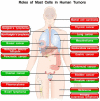Are Mast Cells MASTers in Cancer?
- PMID: 28446910
- PMCID: PMC5388770
- DOI: 10.3389/fimmu.2017.00424
Are Mast Cells MASTers in Cancer?
Abstract
Prolonged low-grade inflammation or smoldering inflammation is a hallmark of cancer. Mast cells form a heterogeneous population of immune cells with differences in their ultra-structure, morphology, mediator content, and surface receptors. Mast cells are widely distributed throughout all tissues and are stromal components of the inflammatory microenvironment that modulates tumor initiation and development. Although canonically associated with allergic disorders, mast cells are a major source of pro-tumorigenic (e.g., angiogenic and lymphangiogenic factors) and antitumorigenic molecules (e.g., TNF-α and IL-9), depending on the milieu. In certain neoplasias (e.g., gastric, thyroid and Hodgkin's lymphoma) mast cells play a pro-tumorigenic role, in others (e.g., breast cancer) a protective role, whereas in yet others they are apparently innocent bystanders. These seemingly conflicting results suggest that the role of mast cells and their mediators could be cancer specific. The microlocalization (e.g., peritumoral vs intratumoral) of mast cells is another important aspect in the initiation/progression of solid and hematologic tumors. Increasing evidence in certain experimental models indicates that targeting mast cells and/or their mediators represent a potential therapeutic target in cancer. Thus, mast cells deserve focused consideration also as therapeutic targets in different types of tumors. There are many unanswered questions that should be addressed before we understand whether mast cells are an ally, adversary, or innocent bystanders in human cancers.
Keywords: angiogenesis; cancer; inflammation; lymphangiogenesis; mast cells.
Figures



Similar articles
-
Eosinophils: The unsung heroes in cancer?Oncoimmunology. 2017 Nov 13;7(2):e1393134. doi: 10.1080/2162402X.2017.1393134. eCollection 2018. Oncoimmunology. 2017. PMID: 29308325 Free PMC article. Review.
-
Controversial role of mast cells in skin cancers.Exp Dermatol. 2017 Jan;26(1):11-17. doi: 10.1111/exd.13107. Epub 2016 Oct 24. Exp Dermatol. 2017. PMID: 27305467
-
Mast Cells, Angiogenesis and Lymphangiogenesis in Human Gastric Cancer.Int J Mol Sci. 2019 Apr 29;20(9):2106. doi: 10.3390/ijms20092106. Int J Mol Sci. 2019. PMID: 31035644 Free PMC article. Review.
-
Basophils in Tumor Microenvironment and Surroundings.Adv Exp Med Biol. 2020;1224:21-34. doi: 10.1007/978-3-030-35723-8_2. Adv Exp Med Biol. 2020. PMID: 32036602 Review.
-
Innate effector cells in angiogenesis and lymphangiogenesis.Curr Opin Immunol. 2018 Aug;53:152-160. doi: 10.1016/j.coi.2018.05.002. Epub 2018 May 17. Curr Opin Immunol. 2018. PMID: 29778674 Review.
Cited by
-
Mast cells and tryptase are linked to itch and disease severity in mycosis fungoides: Results of a pilot study.Front Immunol. 2022 Aug 10;13:930979. doi: 10.3389/fimmu.2022.930979. eCollection 2022. Front Immunol. 2022. PMID: 36032167 Free PMC article.
-
Development and validation of a combined ferroptosis and immune prognostic signature for lung adenocarcinoma.Transl Cancer Res. 2022 Oct;11(10):3620-3633. doi: 10.21037/tcr-22-992. Transl Cancer Res. 2022. PMID: 36388044 Free PMC article.
-
An Immune-Related Gene Signature for Predicting Survival and Immunotherapy Efficacy in Esophageal Adenocarcinoma.Med Sci Monit. 2023 Aug 26;29:e940157. doi: 10.12659/MSM.940157. Med Sci Monit. 2023. PMID: 37632137 Free PMC article.
-
Mast cell marker gene signature in head and neck squamous cell carcinoma.BMC Cancer. 2022 May 24;22(1):577. doi: 10.1186/s12885-022-09673-3. BMC Cancer. 2022. PMID: 35610596 Free PMC article.
-
A Transcriptomic Insight into the Impact of Colon Cancer Cells on Mast Cells.Int J Mol Sci. 2019 Apr 4;20(7):1689. doi: 10.3390/ijms20071689. Int J Mol Sci. 2019. PMID: 30987352 Free PMC article.
References
-
- Ehrlich P. Beiträge zur Kenntniss der granulirten Bindegewebszellen und der eosinophilen Leukocythen. Arch Anat Physiol (Leipzig) (1879) 3:166–9.
-
- Ehrlich P. Über die specifischen Granulationen des Blutes. Arch Anat Physiol (Leipzig) (1879):571–9.
Publication types
LinkOut - more resources
Full Text Sources
Other Literature Sources

